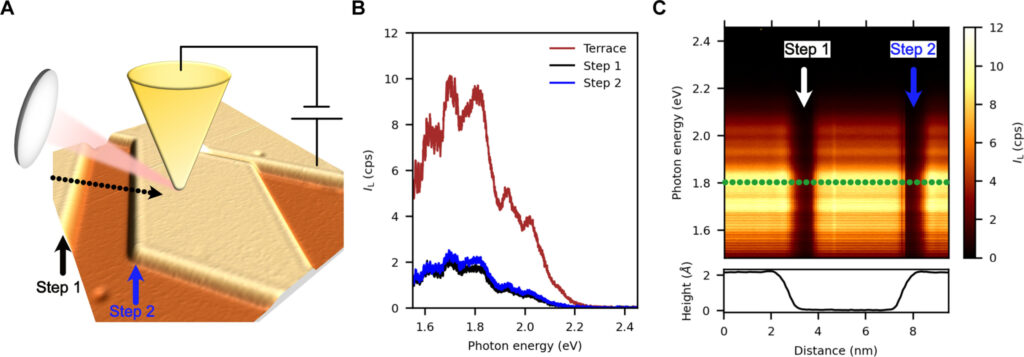Researchers from Madrid explain a phenomenon that allows the direction of light emission to be controlled at the atomic scale. The paper provides a detailed explanation of how the profile of the light collected in a scanning tunneling microscope (STM) experiments changes when the tip is placed on an atomic step.
The properties of light in the far field are determined by what happens in the near field. The manipulation of light at the nanometer scale, below its wavelength, can be carried out in STM microscopes because the electromagnetic field is extremely confined between two metal nanostructures, the tip of the microscope and the sample, both separated by a typical distance of 1 nanometer. This configuration is called a nanocavity.
If an element is introduced into this nanocavity, such as an atomic defect, the system becomes a picocavity and has unique properties. It has been observed that, by introducing atomic steps into the nanocavities, it is possible to modify the direction of light emission in the experiments. This phenomenon, which researchers had previously observed, lacked a scientific explanation until now.
Researchers at IMDEA Nanociencia (Spain), led by Alberto Martín Jiménez and Roberto Otero, have made measurements of the radiated light in an experiment with a picoantenna composed of a gold STM tip and a smooth surface of silver atoms with an atomic step. The findings are published in the journal Science Advances.
During a typical measurement with an STM microscope, the tip travels across the sample, sweeping the surface back and forth as it picks up the signal. The researchers observed that the light emitted by each electron tunneling with the right energy on a monatomic step can be greater or less than that collected when the electron is injected into the atomically flat part of the surface.
By a comprehensive characterization of the light emitted by many steps, the researchers realized that the parameter that governs the intensity of light per electron is the relative orientation between the directions of the step and the direction of light collection, thus demonstrating that the emission of light is not equally distributed in all directions of space, but some are preferred to others with a cardioid-type directional profile.
In collaboration with researchers at IFIMAC-UAM, the authors elucidated the mechanism by which light emission is modified. In their work, they rationalize that in cavities as small as those between the tip and the STM sample an atomic size defect is enough to cause a significant redistribution of the electric field.
The effect is very different on both sides of the step, thus explaining why the angular profile of light emission depends on the orientation of the step. This phenomenon can be exploited to make a picoantenna, an element at the nanoscale with which to control the directionality of the emitted light.
Thus, in order to determine the electromagnetic field (light) emitted in the near field, it is not only necessary to take into account the point-sample structure of the microscope, but also the configuration and defects of the sample being swept, at the atomic scale, since a single atomic defect can modify the direction in which this radiation is emitted.
The authors see potential in this method to eventually tune the direction of light emission from molecules, quantum dots, or other quantum emitters. Investigating the optical properties of atomic objects is crucial not only to advance our knowledge but also to be able to design systems that have applications, for example, in quantum computing.


